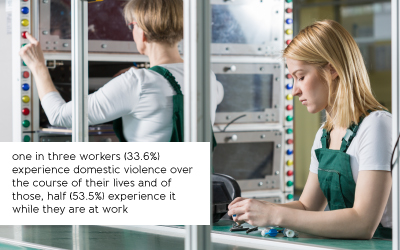Domestic violence is an economic barrier for women
The Province of Ontario is seeking input on women’s economic empowerment with an online survey that is open until August 15th. The Ministry of the Status of Women will be drafting Ontario’s first strategy in the coming months. Any discussion on improving women’s economic opportunities should make a clear link to the impacts of domestic violence on women’s careers and economic status. Women with a history of domestic violence are more likely to work in low paying, casual and precarious jobs, they have interrupted work histories and change jobs more often.[1] The prevalence rates and implications for workplaces were highlighted in the 2014 national study on domestic violence at work, Can Work Be Safe When Home Isn’t which captured the experiences of over 8,000 Canadian workers. We learned that one in three workers (33.6%) experience domestic violence over the course of their lives and of those, half (53.5%) experience it while they are at work.

Women in abusive relationships are at a heightened risk of victimization when, and potentially because, they seek job training or work outside the home.[2] When a woman finds a job, abusive partners may impede her ability to get to work, interfere with her ability to carry out her responsibilities and/or harass or stalk her through phone calls, email or text messages. It is not surprising that domestic violence often first ‘shows up’ at work as a performance issue. There is increasing recognition that employment carves out a pathway that provides critical options for women in abusive relationships.
Without training and skill-building to recognize and respond to warning signs and risk factors, managers and supervisors are unlikely to ask the right questions or address the real issues. They are more likely to see her as the problem to be solved.
"8.5% of workers experiencing domestic violence reported losing their job due to domestic violence" - Can Work Be Safe When Home Isn't?
If a woman perceives her job is in jeopardy, she may try harder to conceal what is happening or give up and leave. Either way, it is a significant issue for her, the employer and the broader society. The economic cost of violence in relationships is mostly born by individual workers. There is also a cascade of varying impacts across socio-economic categories, landing heavily on the already burdened public health infrastructure. [3] Those who push back on the costs of addressing domestic violence do not see the higher costs of not addressing it.

The Ontario Government has shown strong leadership in taking stands on multiple issues related to sexual and domestic violence. In 2010, the Occupational Health and Safety Act was amended to protect workers from domestic violence. In 2015 the Act was further amended to include stronger protections from sexual harassment. Currently, public consultations are beginning for Bill 148 to include paid leave for domestic and sexual violence under Employment Standards legislation. These are important structural changes that make it clear that sexual and domestic violence are not private problems to be solved by individuals. Rather they are social problems that are a matter of public concern.
We need strategies to stop the violence before it happens—and to support those living with violence. This is cultural change that requires a long‑term commitment from everyone in the community to effect genuine change in our beliefs and behaviours. The Ontario Government has demonstrated leadership but is not equipped to bring about cultural shift on its own. It is going to take a coordinated and united effort. Our business, leaders need to help drive this change.
When workplaces recognise domestic and sexual violence as a workplace issue and support workers they join the growing number of leaders who are creating safe, supportive and socially just workplaces and communities. In a future blog, we will talk about how it is good for our collective bottom-line too.
This strategy to increase the economic empowerment of women will be strengthened by acknowledging domestic violence as a barrier to employment. We can build on the workplace legislation that is in place and under consideration to strengthen our shared responsibility and to understand the concrete changes that are needed in every workplace to reduce risk, increase safety and support workers experiencing abuse in meaningful ways. It all adds up to economic independence for more women.
Take action: Add your voice by filling out the survey by August 15th.
Suggested recommendations/ideas:
· Include specific reference to domestic and sexual violence as economic barriers for workers
· Align the strategy to reinforce provincial action plans to address sexual and domestic violence against women
· Build public/private/nonprofit partnerships to improve women’s economic security by working with VAW community partners / coordinating committees and other ministries to disseminatet existing campaigns to Ontario employers (Make It Our Business, It’s Never Okay)
· Engage large employers as safe and supportive workplace champions (start with the Ontario Public Service as the largest employer in Ontario)
· Train Ministry of Labour investigators on domestic and sexual violence






